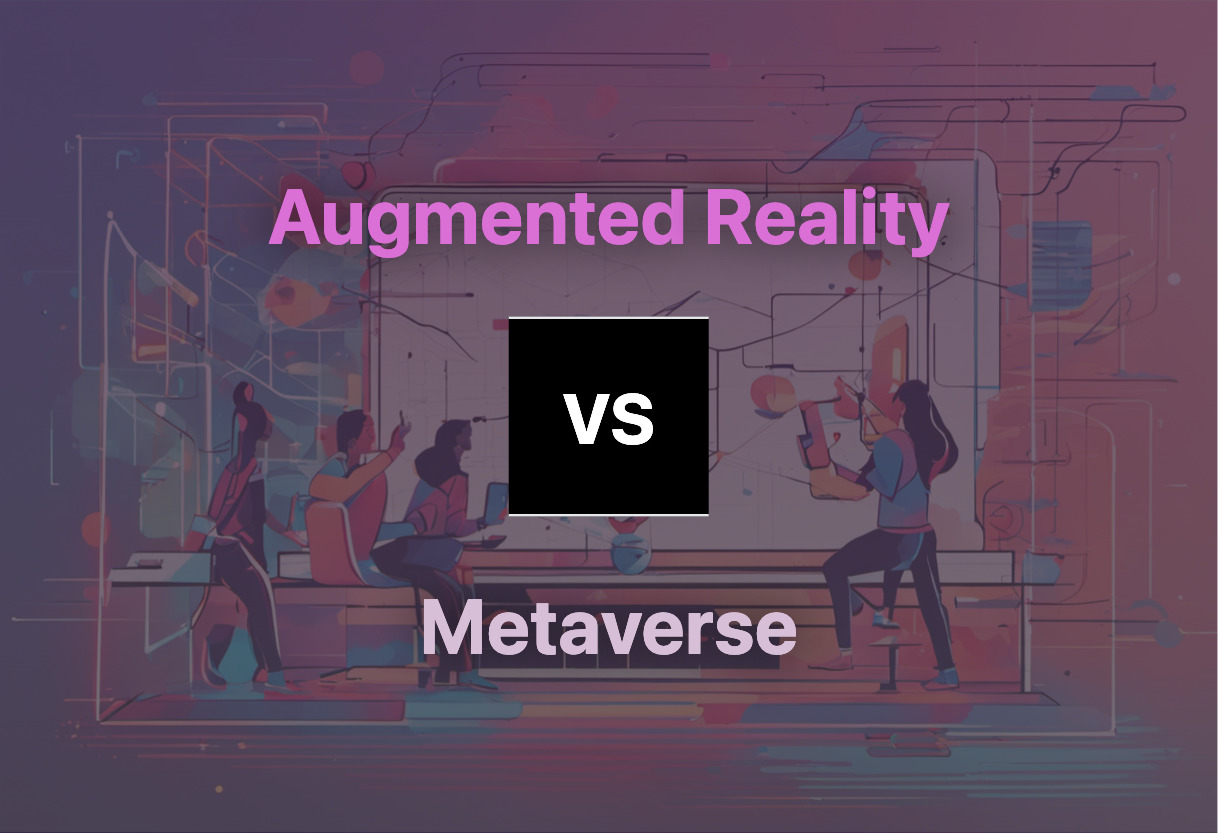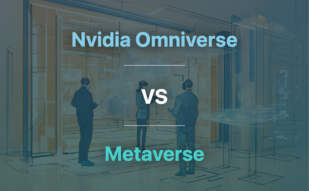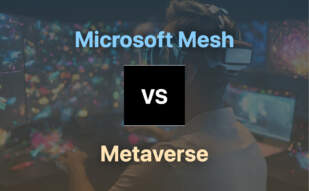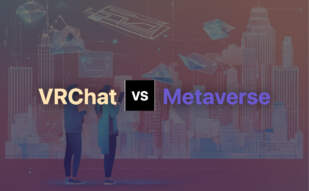For a seamless blend of real and digital worlds, enhancing user interaction with everyday environments, Augmented Reality is the choice. If aiming for a fully immersive digital ecosystem with consumer and industry targeted 3D realms, underpinned by VR and AR experiences, then the Metaverse reigns supreme.

Key Differences Between Augmented Reality and the Metaverse
- AR replaces the real world partially, while Metaverse aims to create a completely immersive digital universe.
- AR relies on mobile devices and specialized AR glasses, Metaverse would potentially rely on an array of VR and AR devices alongside seamless internet connectivity.
- AR finds applications across retail, gaming, manufacturing, etc. Metaverse as a concept will appeal to entire industries, alongside individual users.
- AR technology matures with object recognition, realistic interactions. The Metaverse’s development depends on haptic technology and a network of shared 3D spaces.
| Comparison | Augmented Reality (AR) | Metaverse |
|---|---|---|
| Initial Development | 1968 by Ivan Sutherland | Concepts date back to Antonin Artaud’s essays, 1938. |
| Integration in Devices | Mobile devices powerful enough for AR; AR glasses for immersive experience | Varying devices; highest immersive experience with VR goggles |
| Key Enabling Technologies | AI, AR software, Processing, Lenses, Sensors | VR, AR, Blockchain, NFTs |
| Scope of Application | Marketing, Fashion, Tourism, Retail, Entertainment, Gaming, Learning, Manufacturing | Consumer and industrial target in numerous 3D worlds; Retail, Marketing |
| Novel Contributions | AR overlay; Real-time interaction; 3D recognition; Virtual ‘try-on’; Real-time augmentation | Immersive 3D environments; Interoperability of assets across worlds; Shared 3D spaces; Internal economy |
| Key Technological Milestones | Trimble Navigation’s outdoor helmet-mounted AR system, 2004; First commercial app for AR, 2008 | Sensorama, 1962; First VR headset VPL, 1984; Proof of Work, 1993; Second Life, 2003; Oculus, 2012; Mesh, 2021 |
| Potential/Future Applications | Remote work, Enhanced collaboration; Future support to cultural institutions | Harmonised commerce; Interoperable identities; Metaverse economy |
| Growth Factor | Increasing popularity of AR games/apps, expanded 5G network | Ongoing investments, active market response |
What Is AR Technology and Who’s It For?
AR, or Augmented Reality, is a ground-breaking technology that employs digital components, physical backgrounds, and real-time interactions to augment real-world reality. Originating with the seminal work of Ivan Sutherland in 1968, AR devices are built with cameras and sensors for processing image and interaction data, creating an immersive experience through glasses or camera lens. Manufacturers use depth tracking technology and SLAM (Simultaneous Localization And Mapping) for AR interfaces.
AR is intended for a broad audience, with applications within retail, entertainment, gaming, learning, manufacturing, amongst others. AR tech holds special promise for remote work and enhanced collaboration, and its usage is steadily growing with the increasing popularity of AR games, apps, and expanded 5G network.

Pros of AR Technology
- Enhanced Customer Engagement
- Interactive Learning and Training Purposes
- Enhanced Remote Working and Collaboration
- Unlimited Potential In Various Industries
Cons of AR Technology
- Potential Privacy and Security Issues
- Costly Hardware and Software
- Reliance On High-Speed Internet
- Health Concerns Including Eye Strain
What Is The Metaverse and Who’s It For?
The Metaverse refers to an extensive mixed reality space, imagined as a collective virtual shared space created by the convergence of physical and virtual realities. The Metaverse concept, fueled by Facebook’s rebrand to Meta, spans decades and envisions an immersive 3D internet, harmonizing VR, AR, blockchain and NFTs.
The Metaverse is being designed for an array of potential users, from consumers looking for a new immersive gaming or social experience to industries seeking a comprehensive digital transformation. This inherently brings different technologies, like VR, AR, and blockchain, together under one roof creating a cosmos of interconnected 3D worlds.

Pros of The Metaverse
- Enhanced Social and Gaming Experience
- Expanded Business Opportunities
- Interoperability of Various Technologies
- Boost in Virtual Realty and Digital Assets
Cons of The Metaverse
- Significant Digital Infrastructure Required
- Risk of Digital Addiction
- Accessibility and Equity Challenges
- Uncertain Regulations and Policies
Augmented Reality vs Metaverse: Pricing
Both technologies boast of intricate infrastructural support, with pricing dependent on the nature and extent of interactive experiences offered to users.
Augmented Reality
Augmented reality (AR) accrues costs from the necessary hardware (AR glasses, compatible mobile devices) and software, with expenses rising with the complexity of AR experiences. Specific pricing information for AR can be challenging to define, given it’s embedded across numerous applications across various industries – retail, entertainment, gaming, learning, and manufacturing. Furthermore, the use of advanced technologies like SLAM (Simultaneous Localization And Mapping), image and object recognition, and depth tracking may influence overall costs.
Metaverse
The cost of engaging with the Metaverse can differ greatly based on the platform’s sophistication and the nature of the user’s involvement. Commercial ventures like retail and marketing campaigns by companies like Nike, McLaren, and Walmart suggest the probable expenses one may encounter. The use of VR or AR equipment, special headsets or glasses, and access to certain experiences or digital goods within the Metaverse can all contribute to the cost. Furthermore, investment into the Metaverse, shown by Facebook’s parent company Meta’s $10 billion investment, suggests substantial expenses associated with building Metaverse infrastructures.
Code Examples for Augmented Reality & Metaverse
Creating an Interactive AR Scene with A-Frame
Let’s create an interactive AR scene using A-Frame, a top-tier web-VR framework. You need a modern web browser with WebXR support (i.e., Chrome or Firefox).
<a-scene embedded arjs>
<a-box position='0 0.5 -3' material='color: yellow; opacity: 0.5;'>
<a-animation attribute="rotation" to="0 360 0" dur="5000"
repeat="indefinite"></a-animation>
</a-box>
<a-marker-camera preset='hiro'></a-marker-camera>
</a-scene>
A Basic Blockchain in Metaverse with Node.js
This snippet establishes a simple but functional blockchain inside the Metaverse using JavaScript (Node.js). Ensure that the crypto-js library is installed for hashing blocks.
// Import crypto-js/SHA256 library
const SHA256 = require("crypto-js/sha256");
class Block {
constructor(index, timestamp, data, previousHash = '') {
this.index = index;
this.timestamp = timestamp;
this.data = data;
this.previousHash = previousHash;
this.hash = this.calculateHash();
}
calculateHash() {
return SHA256(this.index + this.previousHash + this.timestamp + JSON.stringify(this.data)).toString();
}
}
Augmented Reality vs Metaverse: Determining Your Tech Path
As developers, gamemakers, AR/VR creators and tech enthusiasts defining your next technology integration path, making the right choice between Augmented Reality (AR) and Metaverse is crucial. The decision trickles down to specific needs, objectives and audience reach. Here’s to some insightful delineations.
AR/VR/Game Developers
For developers grappling complex spatial challenges, AR shines in its relevance particularly if SLAM (Simultaneous Localization And Mapping) technology is your go-to. Given AR embeds real-time augmentation within environmental context and allows accurate 3D recognition of real/virtual objects, the choice is clear. The possibilities are endless, from creating immersive AR games to developing AR apps that seamlessly blend the real and digital world.

Marketers
Authoritatively, AR technology has found triumphant inroads in the field of marketing, fashion, tourism, and retail arenas (first commercial AR application for advertising surfaced in 2008 by German agencies in Munich). Coupled with AI and the fast-evolving 5G technologies, AR is the perfect fit for marketers aiming to create engaging and interactive customer experiences that connect the physical and digital world.

Cultural Institutions
AR holds a unique value in augmenting cultural, historical, and geographical learning experiences. The ability to project digital contents within real-world settings enhances exploration and interaction with invaluable aspects of our environment, making AR a crucial technology for cultural institutions.

Businesses Exploring Metaverse
For businesses ready to pivot to a future that’s virtual, Metaverse, with its raging popularity and vast potential, might clinch the deal. As large corporations like Nike, Tommy Hilfiger, McLaren, and Walmart leap into the metaverse pool for retail and marketing, the path is paved for enterprises planning to capitalize on this 3D internet phenomenon.

In the final analysis of AR vs Metaverse, the choice is largely contingent on the emerging needs of the end-users and the immersive experience intended. AR excels in overlaying digital elements in real-world settings, making it versatile in diverse sectors whereas Metaverse, conceptualized as immersive 3D internet, is ideal for establishing a complete virtual presence.
Grant Sullivan
Content writer @ Aircada and self proclaimed board game strategist by day, AI developer by night.





